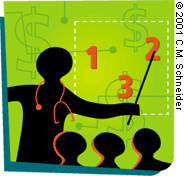
The reimbursement might make it worth your time to become an accredited diabetes educator.
Fam Pract Manag. 2001;8(4):14-15

Medicare recently made some changes in the rules for outpatient diabetes self-management training, which we first told you about in April 1999 (see “Billing Medicare for Diabetes Self-Management Training,” FPM, page 10). Here's a quick review of the rules.
Who may furnish the training
Outpatient diabetes self-management training may be furnished by any physician, individual or entity that meets the following conditions:
The person or entity must furnish other services for which direct Medicare payment may be made and must otherwise be eligible to receive Medicare payments under Medicare's rules governing assignment and reassignment of benefits. (See “A Quick Review of Reassignment Can Help Avert Fraud Accusations,” FPM, September 1998, page 21.)
The person or entity must be accredited in diabetes education, meaning the person or entity has met a set of quality standards approved by the Health Care Financing Administration (HCFA). These can be HCFA's own standards, the National Standards for Diabetes Self-Management Education Programs or the standards of a “national accreditation organization that represents individuals with diabetes” (e.g., the American Diabetes Association).
Individuals or entities must submit proof of their accreditation to HCFA. They must also agree to submit to HCFA validation of the accrediting organization's process and authorize the accrediting organization to release to HCFA a copy of their most recent accreditation evaluation, plus any other accreditation-related information that HCFA may require.
The person or entity providing the training must also provide to HCFA documentation such as diabetes outcomes measurements, as requested.
The individual or entity must allow the area peer review organization to access beneficiary or group training records.
Conditions of coverage
The training must meet three conditions to be covered by Medicare. First, it must be ordered by the physician (or qualified non-physician practitioner) who is treating the beneficiary's diabetes. Second, it must be included in a comprehensive plan of care. Third, it must be “reasonable and necessary,” from Medicare's perspective, for treating or monitoring the beneficiary's condition.
Likewise, a beneficiary receiving training must meet certain coverage conditions. Specifically, he or she must have one or more of the following conditions within the 12 months before the training begins:
New-onset diabetes;
Inadequate glycemic control (i.e., an HbA1C level of 8.5 or more on two consecutive determinations at least three months apart);
Change in treatment either from no diabetes medication to any diabetes medication or from oral diabetes medication to insulin;
High risk for complications based on inadequate glycemic control (i.e., documented acute episodes of severe hypoglycemia or severe hyperglycemia requiring ER visits or hospitalization);
High risk for at least one of the following documented complications: lack of feeling in the foot or other foot complications (e.g., ulcers); pre-proliferative retinopathy or prior laser treatment of the eye; or kidney complications manifested by albuminuria or elevated creatinine.
Types and frequency of training
Medicare covers two types of training. One is initial training. It must be furnished within a continuous 12-month period and may not exceed a total of 10 hours. Of that 10 hours, nine should be furnished in a group setting consisting of two to 20 individuals (not all of whom have to be Medicare beneficiaries), and one hour may be an individual session to assess the beneficiary's training needs. The training must be furnished in increments of no less than one-half hour.
An exception to the group training requirement exists when either no group session is available within two months of the date the physician orders training or the physician documents that the beneficiary has special needs (e.g., language limitations) that will hinder effective participation in group training. Note that initial training is a one-time benefit for beneficiaries; Medicare only pays for it once.
Medicare also covers follow-up training as long as it begins at least one calendar year following the beneficiary's initial training. Follow-up training may not exceed two hours of individual or group training per year for a beneficiary, and it must be furnished in increments of no less than one-half hour. Finally, the physician must document the specific medical condition that the follow-up training must address in both the referral for training and the beneficiary's medical record.
Is it worth it?
To actually get paid for diabetes training, you will need to file a claim with Medicare using one of the following HCPCS codes:
G0108, “Diabetes outpatient self-management training services, individual, per 30 minutes,”
G0109, “Diabetes self-management training services, group session (2 or more), per 30 minutes.”
In 2001, the participating physician allowance for G0108 under the Medicare fee schedule is $63.13 (unadjusted for geographic locality). The corresponding allowance for G0109 is $37.11. Remember when using G0109 that you can have up to 20 people in the training group, making reimbursement for the service quite reasonable. For example, a group of just three Medicare beneficiaries would generate $111.33 for 30 minutes of training.
Of course, whether the reimbursement will justify the hassle of becoming an “approved entity” for purposes of providing outpatient diabetes self-management training will depend on your particular circumstances. If you want to explore the option further, see HCFA's final rule on this subject in the Dec. 29, 2000, Federal Register, which you can access through the U.S. Government Printing Office at www.gpo.gov.